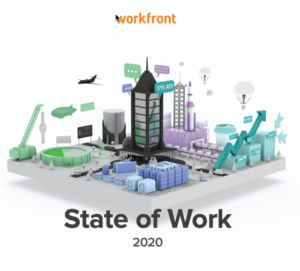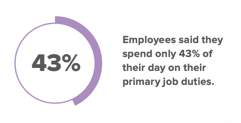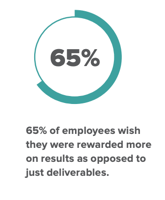We spend so much time working, but much of that time is not terribly productive.
This became shockingly clear when I read the new State of Work 2020 research from my friends at Workfront. It’s a remarkable report, by far the best of its kind. They surveyed nearly four thousand knowledge workers from around the globe and discovered several fascinating findings about how we work, and what impedes that work.
I very much suggest you download and read the entire report. It’s fascinating, encouraging, frustrating, and motivational, and I don’t see much research that can fit all of that into a few pages + charts.
It asks a big and important question:
There is a class of companies that consistently outperforms the competition. Why? How do they change pressure into an opportunity? What sets these organizations apart year after year?
The answer, at least in part, is work … and workers.
Per the report: “These companies have the ability to put relentless pressure on work performance while simultaneously creating a culture that is positive, open and honest.
These organizations also support their people with the applications and systems they want and need. But, they also put in place a digital backbone that ties together individual tools into an orchestrated whole, supporting dynamic work processes, and capturing information that supports visibility and context.
Rather than simply make existing work easier or more fluid, they actually take on a more dynamic approach, working across departmental seams, changing more often, empowering new leaders, and redeploying themselves at the individual, team, or even organizational level…”
I like the sound of that, and it’s what I try to do here at Convince & Convert, on a modest scale.
The State of Work 2020 report is quite thorough — especially given its global scope — so I wanted to summarize for you what are the most interesting findings from my perspective.
Most Employees Care About Work
According to this research, 78% of knowledge workers say their job represents more than a paycheck. That’s encouraging!
78% of knowledge workers say their job represents more than a paycheck. #stateofwork Click To Tweet
No Shame
91% of surveyed workers say they are proud of the work that they do. Excellent!
91% of surveyed workers say they are proud of the work that they do. #stateofwork Click To Tweet
But, So Much Wasted Time
 The report found that knowledge workers globally spend just 43 PERCENT of their time at work doing their actual job function. Meaning that 57% of their time is taken up by other stuff.
The report found that knowledge workers globally spend just 43 PERCENT of their time at work doing their actual job function. Meaning that 57% of their time is taken up by other stuff.
Workers spend just 43 PERCENT of their time at work doing their actual job function. #stateofwork Click To Tweet
Start Over, and Over and Over
Knowledge workers are interrupted nearly 14 TIMES every day by messaging, unexpected calls, and the dreaded “pop in” to their workspace. One of the many reasons I work from home!
Knowledge workers are interrupted nearly 14 TIMES every day by messaging, unexpected calls, and the dreaded pop in to their workspace. Click To Tweet
Workers Wanna Know Why
Fewer than half of all survey participants globally (46%) believe that business decisions are based on data. Yikes.
Cause and Effect
 On a related front, nearly two-thirds of respondents (65%) say they wish they were rewarded more based on results, rather than deliverables. That’s great news! However, if they don’t believe execs are using data to make decisions, it’s pretty tough to compensate the team based on success metrics that are not volume-based.
On a related front, nearly two-thirds of respondents (65%) say they wish they were rewarded more based on results, rather than deliverables. That’s great news! However, if they don’t believe execs are using data to make decisions, it’s pretty tough to compensate the team based on success metrics that are not volume-based.
65% of employees say they wish they were rewarded more based on results, rather than deliverables. #stateofwork Click To Tweet
Behind the Times
This surprised me, given the massive investments companies of all sizes have made — and are making — on technology, but 87% of respondents believe leaders in their organization should reconsider how technology is used. I call this the “maybe Slack is hurting more than helping” phenomenon.
How Many Log-ins Are Too Many?
One of the biggest pain points for knowledge workers is how they actually plan and perform that work. The technology pain evidenced above really stands out in this area, as 71% of participants would like to have a single digital destination where they can understand and manage their work. Of course, that’s what Workfront is so good at: bringing order to the chaos of work.
The Five Big Work Management Questions
As you begin (or continue) to ponder how you can facilitate better work in your organization, consider these five, key questions posed in the report, with my thoughts in parentheses:
- Does every person in my organization understand our company strategy and their role in our success? (The former is often accomplished. The latter? Almost never, in my experience.)
- Do leaders in our organization work to ensure people and teams can focus on the work they’ve been hired to lead, drive, and accomplish? (I think, in good organizations, this is typically true.)
- Are we measuring and incentivizing our people for accomplishing tasks and finishing projects, or achieving strategic outcomes? (It should be strategic outcomes, but it’s almost always on “doing stuff.” Part of the problem though is that a lot of executives don’t fully understand the relationship between tactical execution and strategic objectives because they’ve been off the front lines for so long.)
- Are the technology tools we use helping people accomplish their strategic objectives? (I guess I’d answer this with “yes” and “no”? I don’t know a single company that loves all their tools, period. But I also don’t know many that universally hate their tools.)
- Do we provide all of our team members with the “why” behind their work? Are we helping our people and teams align with strategic decisions? (I’m seeing more and more of this. Lesson.ly is a good example. And many of the companies that are doing this are led by Millennials, who may have a different attitude about getting everyone rowing the boat in the same direction.)
Grab your copy of State of Work 2020 please. It’ll make you think about what and how work gets done (or doesn’t) in your own organization, whether you have 2 team members or 200,000.
disclosure: my friends at Workfront are a paid promotional partner of Convince & Convert.
